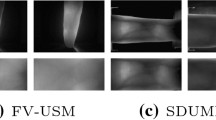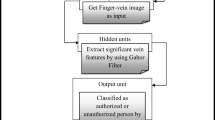Abstract
Recently, finger vein recognition has become integral to biometric technology that uses vein patterns for highly secure personal recognition. Many existing studies reported accurate finger vein recognition systems using recent techniques. However, the existing techniques face high complexity in analyzing vein patterns and increase recognition errors. Hence, this article proposes a novel deep learning (DL) technique for automatically recognizing finger veins at low time complexity. Initially, image de-noising and contrast enhancement are performed in the preprocessing stage using Extended Frost Filtering (Ex-FF) and Entropy Enriched Histogram Equalization (En-HE) to enhance the image's visual quality. The preprocessed images are then fed into the Kernel Attentive Resnet152v2 (KAtt-ResNet152V2) technique to extract the vein features efficiently. The extracted vein features are then fed to the Hybridized Golden Archerfish Optimizer (HyG-ArfO) to select the optimal vein features to reduce the feature dimensionalities. Finally, the optimal features are fed into the Residual Pyramid based Depthwise Separable MobileNetV3 (PyDS-MV3) technique to accurately recognize the person's finger veins. The proposed work is implemented in MATLAB, and a publicly available finger vein dataset is utilized. The performance measures such as accuracy, precision, false discovery rate (FDR), and Mathew's correlation coefficient (MCC) are analyzed and compared with existing studies. The proposed method obtains an overall accuracy of 99.6%, precision of 99.42%, FDR of 0.005 and MCC of 0.994.













Similar content being viewed by others
Data availability
Data sharing is not applicable to this article.
References
Shaheed K, Mao A, Qureshi I, Kumar M, Hussain S, Zhang X (2022) Recent advancements in finger vein recognition technology: Methodology, challenges and opportunities. Inf Fusion 79:84–109
Gururaj HL, Nydile MN, Flammini F, Vidyashree KP, Soundarya BC (2022) Analysis of finger vein recognition using deep learning techniques: finger vein recognition. In: 2022 7th International Conference on Machine Learning Technologies (ICMLT), pp 136–140
Krishnan AS, Ramanathan N, Anirudh M, Rajesh T (2022) A data-driven approach for detecting attacks in finger vein recognition using deep neural networks. Cent Asian J Med Nat Sci 3(6):435–462
Hsia CH, Yang ZH, Wang HJ, Lai KK (2022) A new enhancement edge detection of finger-vein identification for carputer system. Appl Sci 12(19):10127
Tamang LD, Kim BW (2022) FVR-net: Finger vein recognition with convolutional neural network using hybrid pooling. Appl Sci 12(15):7538
Yin Y, Zhang R, Liu P, Deng W, He S, Li C, Zhang J (2022) Artificial neural networks for finger vein recognition: A survey. arXiv preprint arXiv:2208.13341
Li Y, Lu H, Wang Y, Gao R, Zhao C (2022) ViT-cap: A novel vision transformer-based capsule network model for finger vein recognition. Appl Sci 12(20):10364
Zhang Z, Wang M (2022) A simple and efficient method for finger vein recognition. Sensors 22(6):2234
Nguyen HH, Le TN, Yamagishi J, Echizen I (2023) Analysis of master vein attacks on finger vein recognition systems. In: Proceedings of the IEEE/CVF Winter Conference on Applications of Computer Vision, pp 1900–1908
Zhang Z, Wang M (2022) Convolutional neural network with convolutional block attention module for finger vein recognition. arXiv preprint arXiv:2202.06673
Wan ZC, Chen L, Wang T, Wan GC (2022) An optimization algorithm to improve the accuracy of finger vein recognition. IEEE Access 10:127440–127449
Ma B, Wang K, Hu Y (2023) Finger vein recognition based on bilinear fusion of multiscale features. Sci Rep 13(1):249
Lian FZ, Huang JD, Liu JX, Chen G, Zhao JH, Kang WX (2023) FedFV: a personalized federated learning framework for finger vein authentication. Machine Intelligence Research 1–14
Ali AT, Abdullah HS, Fadhil MN (2021) Finger veins recognition using machine learning techniques. Mater Today Proc 1–8
Nguyen NT, Jearanaitanakij K, Selamat A, Trawiński B, Chittayasothorn S, (eds) (2020) Intelligent information and database systems: 12th Asian Conference, ACIIDS 2020, Phuket, Thailand, March 23–26, 2020 Proceedings, Part I, vol 12033. Springer Nature
Naquib FB, Tabassom S, Elahee F, Mim F, Hossai T, Kalpoma KA (2020) Modified Maximum Curvature Method (MMCM) and Logistic Regression: a hybrid architecture for finger vein biometric recognition system. In: 2020 23rd International Conference on Computer and Information Technology (ICCIT). IEEE, pp 1–7
Shakil S, Arora D, Zaidi T (2023) An optimal method for identification of finger vein using supervised learning. Meas: Sens 25:100583
Madhusudhan MV, Udaya Rani V, Hegde C (2023) Finger vein recognition model for biometric authentication using intelligent deep learning. Int J Image and Graph 23(3):2240004
Hameed AS, Al-Azzawi A (2022) Fully automated binary pattern extraction for finger vein identification using double optimization stages-based unsupervised learning approach. arXiv preprint arXiv:2205.03840
Yang W, Luo W, Kang W, Huang Z, Wu Q (2020) Fvras-net: An embedded finger-vein recognition and antispoofing system using a unified cnn. IEEE Trans Instrum Meas 69(11):8690–8701
Al-ogaili H, Shadhar AM (2022) The finger vein recognition using deep learning technique. Wasit J Comput Mathe Sci 1(2):1–1
Boucherit I, Zmirli MO, Hentabli H, Rosdi BA (2022) Finger vein identification using deeply-fused convolutional neural network. J King Saud Univ-Comput Inf Sci 34(3):646–656
Boucetta A, Boussaad L (2022) Biometric authentication using finger-vein patterns with deep-learning and discriminant correlation analysis. Int J Image Graph 22(01):2250013
Shaheed K, Mao A, Qureshi I, Abbas Q, Kumar M, Zhang X (2022) Finger-vein presentation attack detection using depthwise separable convolution neural network. Expert Syst Appl 198:116786
Sulaiman DM, Abdulazeez AM, Zebari DA, Zeebaree DQ, Mostafa SA, Sadiq SS (2022) An attention-based deep regional learning model for enhanced finger vein identification. Traitement du Signal 39(6):1991
Das R, Piciucco E, Maiorana E, Campisi P (2018) Convolutional neural network for finger-vein-based biometric identification. IEEE Trans Inf Forensics Secur 14(2):360–373
Chai T, Li J, Wang Y, Sun G, Guo C, Zhang Z (2023) Vascular enhancement analysis in lightweight deep feature space. Neural Process Lett 55(3):2305–2320
Pulipati S, Ariyarathna V, Jayaweera AL, Edussooriya CUS, Wijenayake C, Belostotski L, Madanayake A (2020) FPGA-based 2-D FIR frost beamformers with digital mutual coupling compensation. In: 2020 IEEE/MTT-S International Microwave Symposium (IMS). IEEE, pp 1077–1080
Lakshmi Kumari Ch, Prasad KV (2022) Optimized deep learning model for spatio-temporal detection and localization of object removal video forgery with multiple feature extraction 1–34
Mohammadi-Balani A, Nayeri MD, Azar A, Taghizadeh-Yazdi M (2021) Golden eagle optimizer: A nature-inspired metaheuristic algorithm. Comput Ind Eng 152:107050
Hu H, Guo J, Wu Y, Nai W, Yang Z, Li D (2022) t-SNE Dimensionality reduction method based on sobol sequence initialized archerfish hunting optimizer algorithm. In: 2022 7th International Conference on Computational Intelligence and Applications (ICCIA). IEEE, pp 43–47
AbdElaziz M, Dahou A, Alsaleh NA, Elsheikh AH, Saba AI, Ahmadein M (2021) Boosting COVID-19 image classification using MobileNetV3 and aquila optimizer algorithm. Entropy 23(11):1383
Qian S, Ning C, Hu Y (2021) MobileNetV3 for image classification. In: 2021 IEEE 2nd International Conference on Big Data, Artificial Intelligence and Internet of Things Engineering (ICBAIE). IEEE, pp 490–497
Ma X, Luo X (2023) Finger vein recognition method based on ant colony optimization and improved EfficientNetV2. Math Biosci Eng 20(6):11081–11100
Wang Y, Lu H, Qin X, Guo J (2023) Residual Gabor convolutional network and FV-Mix exponential level data augmentation strategy for finger vein recognition. Expert Syst Appl 223:119874
Kapoor K, Rani S, Kumar M, Chopra V, Brar GS (2021) Hybrid local phase quantization and grey wolf optimization based SVM for finger vein recognition. Multimed Tools Applic 80:15233–15271
Author information
Authors and Affiliations
Contributions
All authors read and approved the final manuscript.
Corresponding author
Ethics declarations
Ethical approval
This article does not contain any studies with human participants or animals performed by any of the authors.
Consent to participate
All the authors involved have agreed to participate in this submitted article.
Consent to publish
All the authors involved in this manuscript give full consent for publication of this submitted article.
Conflict of interest
Authors have no conflict of interest to declare.
Additional information
Publisher's note
Springer Nature remains neutral with regard to jurisdictional claims in published maps and institutional affiliations.
Rights and permissions
Springer Nature or its licensor (e.g. a society or other partner) holds exclusive rights to this article under a publishing agreement with the author(s) or other rightsholder(s); author self-archiving of the accepted manuscript version of this article is solely governed by the terms of such publishing agreement and applicable law.
About this article
Cite this article
Deshmukh, S.V., Zulpe, N.S. An optimized deep learning based depthwise separable MobileNetV3 approach for automatic finger vein recognition system. Multimed Tools Appl (2024). https://doi.org/10.1007/s11042-023-18070-2
Received:
Revised:
Accepted:
Published:
DOI: https://doi.org/10.1007/s11042-023-18070-2




